- Version Differences -
- INTRODUCTION -
There are no alternatives on the Internet regarding what kind of version differences there are in F-ZERO GX,
so I have finally decided to step in and change that. I will be covering everything I have detected over the years for all of the
four existing versions of the game (NTSC-J, NTSC-U, PAL, NTSC-"K"). The NTSC-K version had very little to cover, so I therefore
decided to include that by itself near the bottom of the page. The other versions will be compared to each other throughout this article.
Also, a useful reminder to those who doesn't already know:
NTSC-J = Japan
NTSC-U = USA, Canada, Mexico, Brazil, etc.
PAL = Europe, Australia
NTSC-K = South Korea
Let's start off with how the different versions starts the game.
To trigger this menu in NTSC versions you have to hold "B" upon starting the game.
In the PAL version this screen is unavoidable.
In the images below I am using the NTSC-J and PAL versions of the game as examples.
NTSC requests whether you want to display the image in progressive mode (480p) or not (480i).
Keep in mind that it's the same in the NTSC-U version, except that it has been translated into English, of course.
However, in the PAL version, the game instead requests whether you want to display the image in either 60Hz (480i) or 50Hz (576i).
*The number in top-right corner of the PAL version is a counter (in seconds) before the game proceeds by itself.
Once zero is reached, whatever option that's selected in yellow will be used.
| NTSC | |

|

|
|
PAL |
|
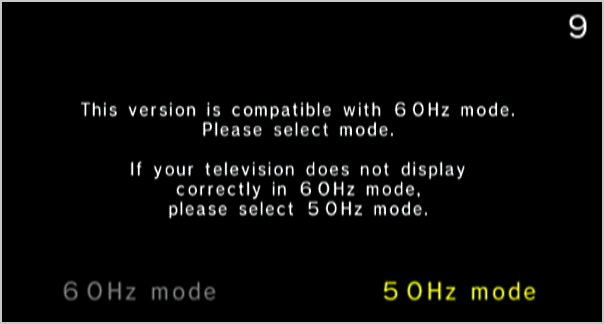
|
|

|
|
Moving on, we have yet another version difference as soon as the title screen appears. If you take a look at the videos provided below, you should notice that the Japanese version displays the "Press Start Button" image instantly upon entering the screen. More interestingly, though, is that you can actually proceed to the main menu right away in this version, while any of the other versions have a preset cooldown of approximately 3 seconds before you can proceed. I didn't do this in the NTSC-J video, but you can in fact proceed already on the first visible frame of the title screen. Another minor thing that changed in the English versions is the "Press Start Button" to "Press Start/Pause".
- MENUS -
In the first image below we have the look of the main menu in all versions of the game. You should notice that the Japanese version
uses a different alignment to fit both the Japanese and English font in a symmetrical way.
Displaying menus in both Japanese and English itself is a very uncommon decision.
Although in the case of F-ZERO GX, it kind of makes sense, considering that the game's style is widely inspired by western comics.
A flaw left in the Japanese version is the use of "Mode Select" instead of "Select Mode" near the top-left.
This is just one of many instances where "Engrish" was left in the Japanese version.
Below we have a lot of instances where the menus were altered between the Japanese and English versions.
*Hover the cursor above the images to see equivalent menus in the English versions.
*More specifically in this case, NTSC-J compared to PAL:
In the last image above, a mistake that was left only in the Japanese version is the background images of Mute City courses.
This is also the case for the Mute City of Chapter 7, which even uses a different image. If you have ever watched
videos that were made during the development time of F-ZERO GX, you may have noticed the less detailed
road texture that was used on Mute City courses. These were probably changed late in
development, causing them to be overlook before the final build. Taking this theory a step
further, F-ZERO AX even got unused data from the development period, with the old road texture used
on a playable, alternate version of Chapter 7.
Video: https://www.youtube.com/watch?v=_6weVVOSdA8
*Blurring the sign of Mute City Sonic Oval's background was not a mistake that was left in, unlike the others.
Surprisingly, subtle menu changes were also made between the NTSC-U and PAL versions. These changes aren't really corrections, though, but rather a change in preference. All of these changes involves the use of different font size, spacing and alignment. The calibration menu in particular, is the first good display of this change. If you hover the cursor above the image below, you should take notice of some differences in font size, spacing and alignment.
*NOTE: The spacing is the same between the NTSC versions. PAL image is blurry because it was captured from console, rather than emulation. Oh, and notice how the developers went too fast and managed to leave the mistake "not change.Adjust play" in, without a space between "change." and "adjust".
The calibration menu is just one example of this. Mr. Darkeye notified to me a few years back that the Staff Ghost menu looked quite different between the NTSC-U and PAL versions:
A somewhat strange change to take notice of here is the exclusion of the Y button near the bottom. You would think this indicates that you can't reload/load another memory card once the Staff Ghost screen has been loaded, but apparently it still works to press Y again.
Speaking of other, perhaps more interesting menu differences, the PAL version includes a unique language menu within the options menu of the game. There are a total of five different languages available to choose from; English, German, French, Spanish and Italian. If I remember correctly, what language the game chooses by default is dependent on the language settings of the console.
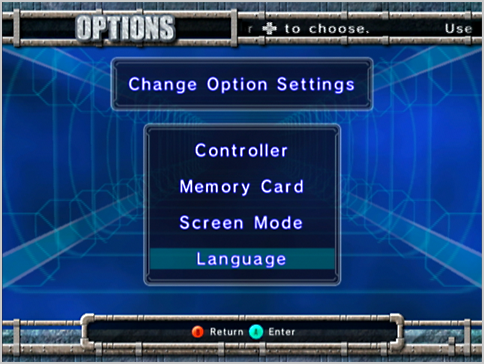
|

|
Changes that are made in later revisions aren't always better than they originally were.
For instance, the first video below demonstrates a more convenient menu used whenever
you decide to leave from a course into the cup/course selection menu.
For some reason, the convenience of having the ability to further exiting into the main menu
from here was removed in versions other than the Japanese version.
Speaking from personal experience, I have had occasions where
I would want to exit into the main menu from entering the cup/course selection, due to hesitation that
I had when I quickly decided on the cup/course selection menu. Having the option to reconsider was definitely the ideal solution.
The lack of the B button option in the English versions is pretty much the indication to take notice of here.
| NTSC-J | NTSC-U / PAL |
But enough about visual menu variations and options. This next change is something I find very surprising that nobody else have taken notice of it.
In the Emblem Editor, it turns out the NTSC-J and NTSC-U/PAL both have their own exclusive sample emblem.
The NTSC-J-exclusive emblem being the kanji (激), was obviously changed, as it didn't make sense to leave it in to a non-Japanese audience.
Instead, the English versions had the emblem changed into a dragon, as seen in the image below.
| NTSC-J | NTSC-U / PAL |
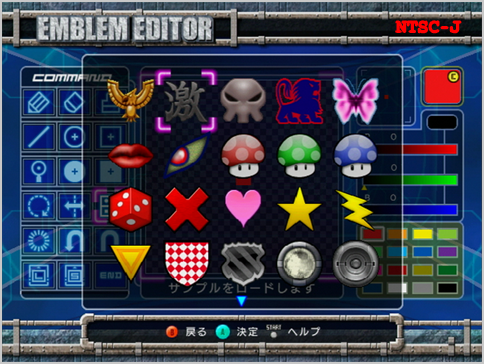
|
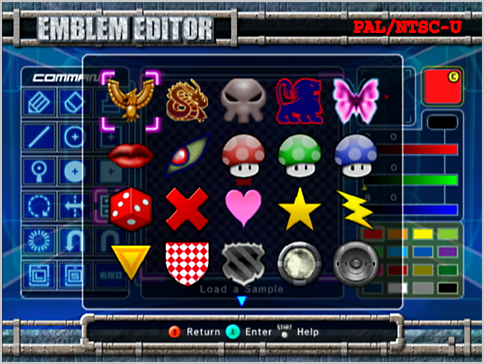
|
- STORY MODE -
Cutscenes are only available in English voice acting. Subtitles are translated accordingly to the version and language settings:
NTSC-J = JP
NTSC-U = EN
PAL = EN, DE, FR, ES and IT
| NTSC-J | NTSC-U / PAL |
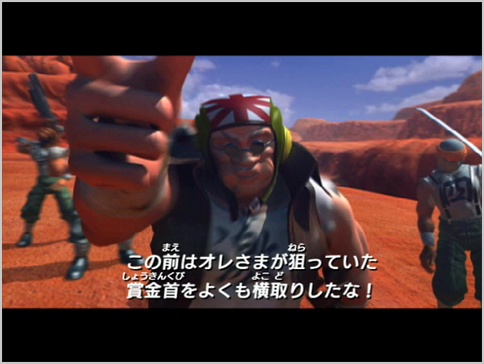
|
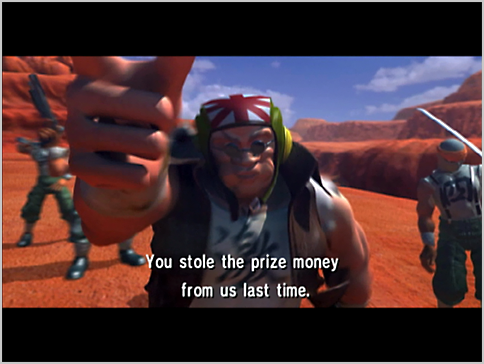
|
The first change that's not so apparent, is the use of "OK" instead of "GET" whenever a capsule is collected in either Chapter 1, or Chapter 5. The icon gets displayed only for a short duration, so it's easily overlooked by those who have played several versions.
| NTSC-J | NTSC-U / PAL |

|
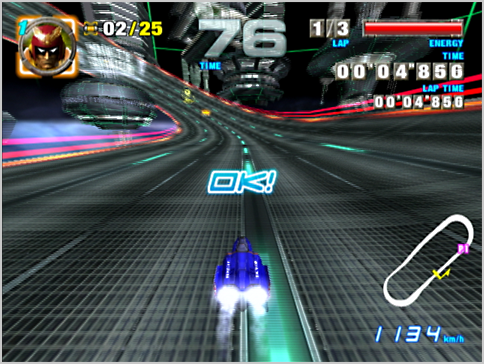
|
Once a mission is cleared, the time you got is displayed as you complete it, but only in the English versions. The Japanese version only displays the record time of the memory card in the chapter selection menu.
| NTSC-J | NTSC-U / PAL |
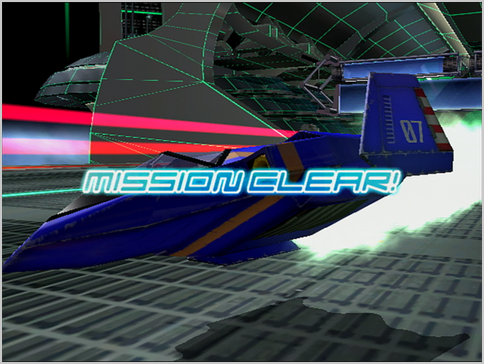
|
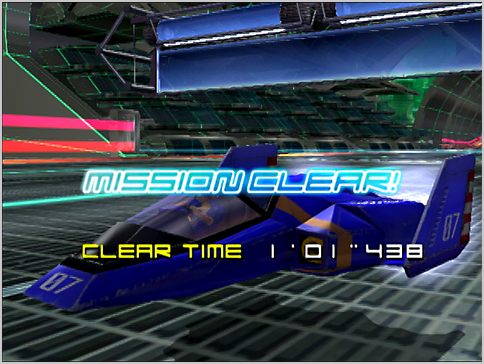
|
Chapter 5 probably serves the most interesting Story Mode change between the Japanese and English versions.
The developers probably decided exactly 40 seconds of time to complete the mission on Very Hard
was too brutal, so a slight alteration was made to how the game allows you to continue a little
bit beyond the time that's given in the chapter description.
NTSC-J compared to PAL/NTSC-U:
You get one second less before the machine ultimately explodes.
Although, even in the English versions of the game, you virtually get about an additional 0"5 (+/- 0"1) of time to succeed.
This is due to the energy depletion and engine failure that occurs upon passing 40 seconds.
The visual time-out is also different between the versions, and the announcer says "Off course!" exclusively in the NTSC-J version as the time is up.
| NTSC-J | NTSC-U / PAL |
- TIME ATTACK -
If you have ever played both Japanese and English versions of the game, one of the first differences you'll possibly take notice of is the huge holographic sign located on Mute City courses that says "減速注意 / GO FAST". To as far as I can understand, the meaning is not actually the same between the two. In Japanese, the game is notifying you to be more cautious and advices you of slowing down. The English version, on the other hand, is more reckless, basically telling you to GO FAST! I suppose the Japanese meaning makes the most sense in correlation with the secondary "CAUTION!!" words of the texture, but I honestly have no complains with GO FAST!
| NTSC-J | NTSC-U / PAL |
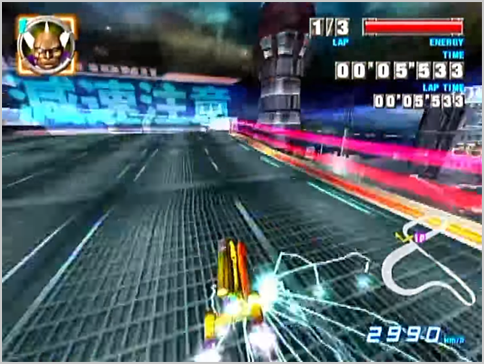
|
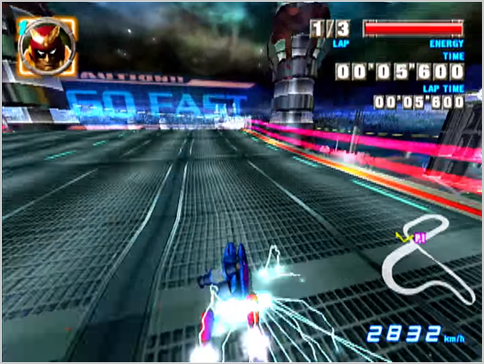
|

|

|
There are quite a few signs that you wouldn't normally pay much attention to, which turns out to have been altered in the English versions. Fortunately, all of them has already been covered in detail at TCRF, so there's no need for me to demonstrate further: https://tcrf.net/F-Zero_GX
The most well-known change between the Japanese and English versions is the renaming of the
Casino Palace course, originally named Vegas Palace. This was possibly changed
to avoid connections with the real city Las Vegas (also known as simply "Vegas").
*Another minor version difference detectable in the bottom-right corner: Lap 3 vs. 3 Lap(s)
| NTSC-J | NTSC-U / PAL |
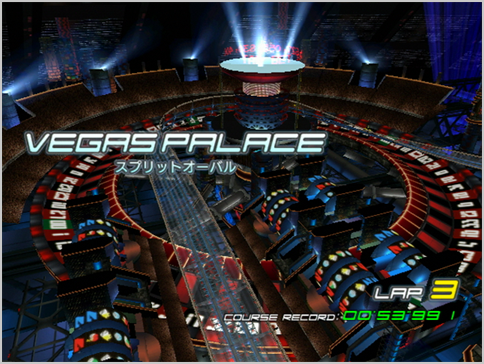
|
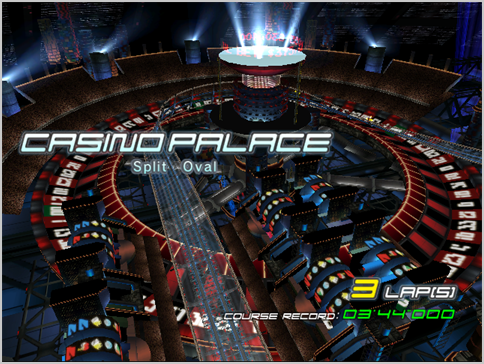
|
A rather bizarre flaw was left in on Port Town - Aero Dive of the Japanese version, where the rail texture in one particular section disappears. I can't actually confirm anything, but this might happen because of how course visuals are always loading in detail by sections (to optimize framerate in conjunction with visual quality). In this particular section of PTAD, perhaps the course details behind the camera were removed too early, making this technique detectable during play? This is just my assumption about how it works, though.
| NTSC-J | NTSC-U / PAL |
The last change we have for Time Attack is the time limit of how quickly you're allowed to complete a course.
If you get a time below 20 seconds in the Japanese version of the game,
the result screen is displayed as it's originally intended to look. In the English versions of the game,
a time limit of 20 seconds (in some cases 1'20) was implemented, causing a GP race end result screen to show up
if the time is pushed that far.
If the GP result screen is triggered, it actually prevents you from saving the time to the record screens.
In addition to that, Ghost Data cannot be saved either. It's only the Replay Data that can still be saved.
It's difficult to say for sure why this is even a thing, but I speculate that it's a rushed and failed attempt
in patching the use of the Space Flying glitch.
| NTSC-J | NTSC-U / PAL |
- PILOT INTERVIEWS -
This has already been covered a few placed on the Internet,
but to mention it briefly here as well, certain interview dialogues were changed
in the English versions, probably due to localisation regulations that needed to be met outside of Japan.
Even if this had been included, I highly doubt it would become an issue in any way.
Especially considering that it's rather well hidden within the game.
Text format of the censured interviews: https://tcrf.net/F-Zero_GX#Interviews
Video showing off the censured interviews:
- CREDITS -
The credits of the game obviously had to be expanded to include the people who contributed
to later releases of the game. A pretty apparent section of the credits that was added
in the PAL version is the list of all the translators who contributed.

- Korean Version - NTSC-"K" -
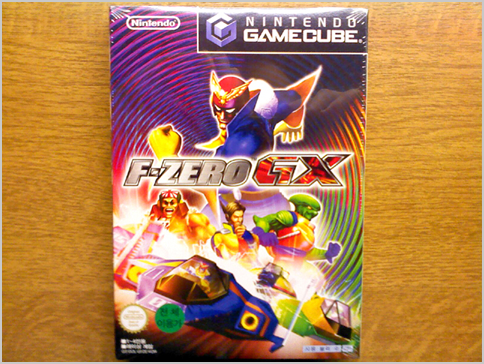
|
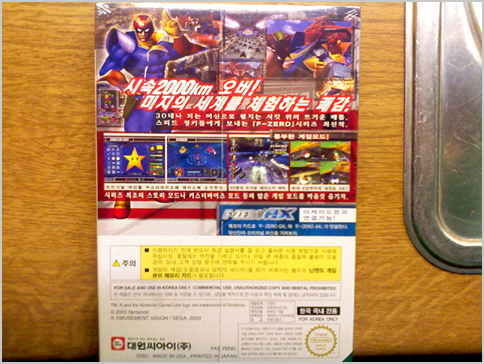
|
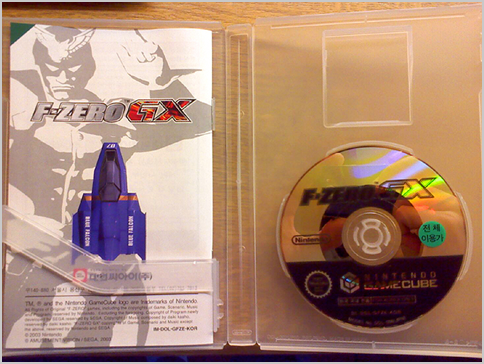
|

|
Disc printing:
FOR KOREA ONLY
DL-DOL-GFZE-KOR
MODEL No. DOL-006(JPN)
I can tell with confidence that I have managed to locate absolutely all of the version differences that the
Korean release of the game has to offer. The biggest changes are in fact the disc printing, and that the
manual and case were translated into Korean. To as far as the actually data of the game goes,
there's next to nothing that has changed. Let me elaborate how this could be determined.
By dumping the ISO through homebrew and making use of a hex-editor,
a side-by-side comparison of the other versions of the game can be done
to detect exactly how much that has changed.
To begin with, we have the start of the ISO, including the region and version/revision of the game:
Offset 0x00000003 = game region
Offset 0x00000007 = version / revision
*Hover cursor above image to display NTSC-K ISO
As you can probably tell by comparing the two images, we have already managed to confirm
that the NTSC-K ISO is actually a modification of the NTSC-U ISO.
The only difference at the very start of the ISO is the version/revision (colored in green).
All versions of F-ZERO GX, with the exception of the Korean release, are labeled as version 1.000.
The Korean version is considered to be version 1.048.
*(30 in hex = 48 decimal)
The second modification that has been done to the Korean version can be located if we scroll down a little bit to offset 0x0000045b.
This offset determines what console region/memory card region (format) the game should search for.
By comparing against the NTSC-U version, we can see that it's not the same (hover):
By adding a comparison against the NTSC-J version instead, we'll see that the offset 0x0000045b matches:
* NTSC-J = 00 - NTSC-U = 01 - PAL = 02
This is a specific region modification which enables NTSC-U games to function with NTSC-J
consoles/memory card formatting. The reasoning for doing this at all has to do with how
South Korea were given a very limited library of games that could be purchased.
The disc (ISO) region that was used varied between being the NTSC-U and NTSC-J versions,
thus making this modification a necessity to implement.
But anyway, continuing on with potential differences, making the hex-editor attempt a search to locate more differences between the true
NTSC-U and Korean NTSC-U versions... and guess what? Data beyond this point is 100% identical.
In conclusion, we have just confirmed that there are literally only two modifications that were made to the
Korean ISO. This is why I labeled NTSC-"K" in quotes earlier, because it's
more accurately defined as just a slightly altered revision of the NTSC-U version.
The only thing that was truly unique to the Korean release was the Korean translation of the manual and case, as already mentioned.
This is pretty much all I have to say regarding version differences of F-ZERO GX. If there's curiosity in how memory card storage works out with the region mismatch, you can keep on reading:
Offset 0x00000003 = game region (secondary region; region of .GCI files within the memory card)
Offset 0x0000045b = console / MC region (primary region; memory card format)
Offset 0x00000003 can be any of the below options:
4a J = NTSC-J
45 E = NTSC-U
50 P = PAL
Offset 0x0000045b can be any of the below options:
00 (J) = NTSC-J
01 (E) = NTSC-U
02 (P) = PAL
| Version | Region & Format | Result |
| Korean | E + J | NTSC-U game on NTSC-J console/MC |
| American | E + E | NTSC-U game on NTSC-U console/MC |
| Japanese | J + J | NTSC-J game on NTSC-J console/MC |
| European | P + P | PAL game on PAL console/MC |
* Region = 0x00000003
* Format = 0x0000045b
What this ultimately means is that both the Korean and Japanese versions can be used on NTSC-J consoles (Korean/Japanese) with NTSC-J memory card formatting. Which region the .GCI files stored to the memory card are doesn't matter, as these can even show up in the memory card management screen of the console. All that matters is that the offset 0x0000045b of the game matches with the console region/memory card formatting. This does not mean you can load any regional .GCI files through the game, though, since the game only searches for .GCI files that matches the game region (offset 0x00000003).
This whole thing might be hard to grasp, but hopefully I succeeded in providing an explanation that's somewhat understandable.
EDIT:
I forgot to mention an interesting rewording that was done in the replay mode.
The Japanese version uses "Select Mode" and "Gamecamera Mode", which were
changed into "Select Camera" and "Game Camera" respectively.
Mr. UchihaSDA mentioned to me that the replay mode uses a different font
between the PAL and NTSC-U/NTSC-J versions.
I checked to confirm, and it turns out to be the case.
Shout-outs to:
Mr. StarkNebula for a lot of his research and publication of hidden content in both F-ZERO GX and F-ZERO AX.
YouTube channel "Censored Gaming" for the video of censorship in F-ZERO GX.
Mr. Darkeye for notifying me with the NTSC-U/PAL Staff Ghost menu difference.
Mr. Mihaila (TAO)'s video of the English title screen.
Mr. BattleStream's image of the Japanese "減速注意 / GO FAST" sign.
Mr. ColonelFXGX's image of the Japanese Chapter 7 background.
Mr. UchihaSDA for notifying me about the NTSC/PAL replay mode font difference.